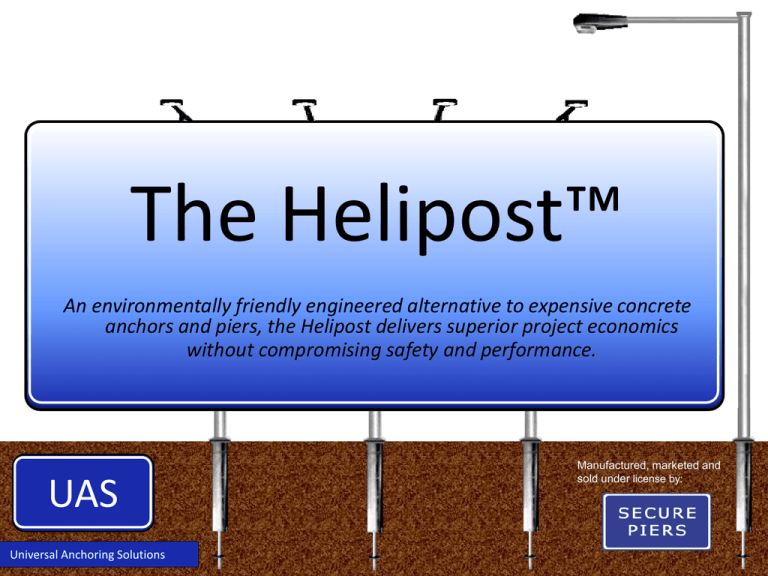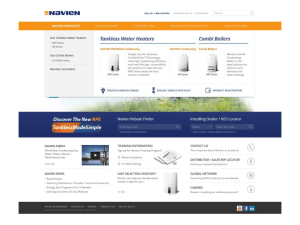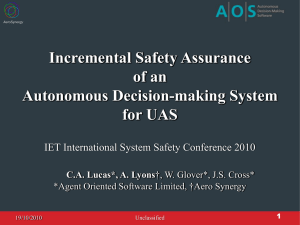Helipost - Mgplanning.com
advertisement

The Helipost™ An environmentally friendly engineered alternative to expensive concrete anchors and piers, the Helipost delivers superior project economics without compromising safety and performance. UAS Universal Anchoring Solutions Manufactured, marketed and sold under license by:: What we cover in this presentation: What is the Helipost? Slides 1.1 – 1.3 Concrete vs. Helipost Slides 2.1 – 2.3 Common Helipost Applications Slides 3.1 – 3.2 Overview of the Helipost Site Engineering Process Slides 4.1 – 4.5 Overview of the Helipost Installation Process Slides 5.1 – 5.8 Why You Need to Use the Helipost Slides 6.1 – 6.3 UAS Universal Anchoring Solutions What is the Helipost? UAS Universal Anchoring Solutions Slide 1.1 What is the Helipost? The Helipost Bearing Plate Thickness .625” – 1.5” Post Assembly Bearing Plate Galvanized Thickness ASTM A123 .875” – 2.0” Slotted Bolt Pattern Casing Casing Thickness .148” – .250” Thickness Casing: ASTM A53 .250” – .375” 3’ – 20’ Long 8” – 24” Wide 2” x 6” US Patent No. 6,722,821 B1 Cutting Teeth Schedule 40 Schedule 80 Central Shaft Central Shaft ASTM A36 Helix Blades Slide 1.2 What is the Helipost? The Helipost Helipost 2 x Helix Cutting Tooth and Mouth of can Helipost SD 12 x 6 Slide 1.3 What is the Helipost? Corrosion and Abrasion Measures Galvanized in accordance with ASTM-123 Design corrosion rates conform with AASHTO & FHWA-RD-89186 metal loss rates Minimal abrasion in 50/6 soil (WSDOT) UAS Universal Anchoring Solutions 4Fe+3O2+4H2+8H+= 2(Fe2O3•H2O)+2OH2O+8H+ Slide 2.1 Concrete vs. Helipost The Problems with Concrete: Complicated - Labor intensive and equipment heavy, with multiple crews necessary to complete the installation process. Expensive – Inefficiencies due to the common logistical challenges, materials, and equipment used for concrete installation add both time and money to the project costs Slow – The curing period required before concrete piers and anchors are ready to accept the above-ground unit adds days or weeks to project schedules. UAS Universal Anchoring Solutions Slide 2.2 Concrete vs. Helipost Concrete vs. Helipost Helipost Concrete Workers 2-3 10-15 Time 2-3 Hours 10 days -3 weeks Equipment 1 piece 3 pieces Site Limitations Almost none Always Weather limitations Never Always Cost Approximately half the cost $$ Expensive $$$$ UAS Universal Anchoring Solutions Common Helipost Applications UAS Universal Anchoring Solutions Slide 3.1 Common Helipost Applications Introduction: Helipost Applications Sound walls and noise barriers Solar panels (ground mounted) Highway signs Light posts Security walls Cell towers (mono pole) Steel buildings Billboards UAS Universal Anchoring Solutions Slide 3.2 Common Helipost Applications Performance Means Multiple Applications Helipost delivers 20 tons of axial load, therefore: Supports walls up to 30 feet Supports high-mast lights up to 100 feet Supports large exit signs and cantilever lights Supports mono-pole cell towers Anchors even large solar panels UAS Universal Anchoring Solutions Overview of the Helipost Site Engineering Process UAS Universal Anchoring Solutions Slide 4.1 Overview of the Helipost Site Engineering Process Site Engineering Process Steps Step 1 – Geotechnical Exploration Categorize major soil units and determine index properties Method A: Group soils according to soil classification Method B: Determine soil index properties through extensive field and laboratory testing Step 2 – Wind Loads Determine shear and overturning moment based on structural attributes Method A: Use AASHTO or ASCE7 wind charts Method B: Hand calculate wind loads using desired method (see appropriate code) Step 3 – Helipost Sizing Determine required foundation size for wind loads Method A: Refer to Helipost sizing charts for the appropriate soil category Method B: Apply rigorous limit state and p-y analysis and check foundation strength Step 4 – Bearing Capacity Calculate weight of structure to be supported and capacity of foundation Method A: Refer to Helipost baring capacity charts for appropriate soil category Method B: Calculate bearing capacity using traditional soil mechanics Step 5 – Corrosion Measures Re-adjust sizes if needed to account for corrosion losses over design life Method A: Observe corrosion chart and adjust size for corrosion category by matching moment and shear while maintaining or increasing size Method B: Determine corrosion losses and adjust Slide 4.2 Overview of the Helipost Site Engineering Process Geotechnical and Soil Classification Slide 4.3 Overview of the Helipost Site Engineering Process Wind Load Analysis Slide 4.4 Overview of the Helipost Site Engineering Process Helipost Sizing Chart Slide 4.5 Overview of the Helipost Site Engineering Process Helipost Bearing Capacity Qu Qu L1 L1 Qu L2 L1 L2 Overview of the Helipost Installation Process UAS Universal Anchoring Solutions Slide 5.1 Overview of the Helipost Installation Process Installation Process Attach pier to torque motor Position for insertion Plumb for post placement Screw pier into ground Mount post on pier cap Lateral load test for safety UAS Universal Anchoring Solutions Slide 5.2 Overview of the Helipost Installation Process Attach Helipost to Torque Drive Slide 5.3 Overview of the Helipost Installation Process Position Helipost for Insertion Slide 5.4 Overview of the Helipost Installation Process Torque Drive into Soil Slide 5.5 Overview of the Helipost Installation Process Attach Helipost to Base Plate Assembly Slide 5.6 Overview of the Helipost Installation Process Base Plate Attaching and Assembly Detail Slide 5.7 Overview of the Helipost Installation Process Kip Load Test Slide 5.8 Overview of the Helipost Installation Process Repeat Installations Why You Need to Use the Helipost UAS Universal Anchoring Solutions Slide 6.1 Why You Need to Use the Helipost Easy Installation NO drill rigs, cranes, or concrete trucks NO concrete curing delays All-weather set-up and installation Attaches to torque motor with only four bolts Ideal in confined job sites UAS Universal Anchoring Solutions Slide 6.2 Why You Need to Use the Helipost Compelling Performance Installs in loose sand to stiff clay Excels in ground water and caving soils Reduces traffic control requirements and project insurance Eliminates drill spoil removal Adjusts easily for both precise positioning and plumbness Torque readings verify soil conditions UAS Universal Anchoring Solutions Slide 6.3 Why You Need to Use the Helipost Efficiency and Flexibility Equals Profitability Eliminate the hassles of concrete Significantly reduce project costs Compress project schedules World-wide market applications UAS Universal Anchoring Solutions Increase profitability Leaner operations Manage more concurrent projects Present a greener profile Win more business!











